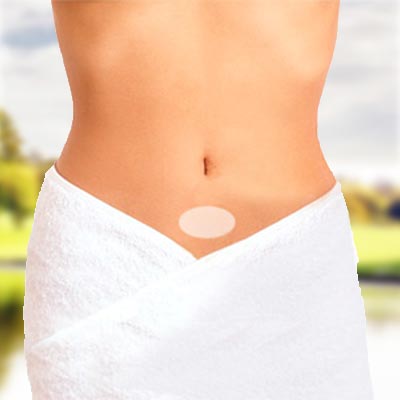Testosterone Patch for Women

In the US it is estimated that about 24 to 43% of women are affected by sexual dysfunction. One of the most prominent causes for loss of sexual desire is decrease in testosterone levels, especially following natural or artificial menopause.
Testosterone patches are transdermal and are construed as safe and effective option in reviving sexual desire in women. These patches are nearly transparent and release small amounts of testosterone into the bloodstream. They release approximately 300 micrograms of testosterone daily and can be applied twice a week.
How does testosterone patch work?
Post menopausal women who have lost interest in sex may bring back their libidos with this testosterone patch.
When the testosterone drops to low levels in the woman's body, the patches can
be applied and the active testosterone ingredient gets absorbed into the body
through the skin. This leads to an increase in testosterone eventually improving
libido and sexual desire. This way, the testosterone patch helps a woman both
physically and emotionally.
Testosterone patches are much better than oral forms as it avoids the hormone getting to the liver first and reaching the target organs. Therefore the risk of liver diseases is much lower in this patch usage.
The American Journal of Obstetrics and Gynecology in its special supplement on Menopause recommends the addition of androgen - testosterone - to estrogen for all women undergoing surgical menopause. The symptom of testosterone deficiency during natural menopause can also be combated to some extent using testosterone patch. As such, testosterone is an important factor in a woman's health and provides several benefits. They include:
- Increases energy levels
- Enhances feelings of well being
- Decreases tenderness of the breast
- Improves relief from vasomotor symptoms of menopause
- Improves sexual desire
- Increases sexual sensitivity and desire
How should testosterone patch be used?
It is important to follow the doctor's instructions while using the patch. The area of the skin (mostly the
lower abdomen, below the navel) should be thoroughly cleaned and then the patch
applied to the area. The same area should not be re-used for applying the patch
for at least a week.
The area where the patch is applied should be free from any irritation or cuts. In addition do not apply lotions, creams and moisturizers to the same area. It is also recommended to initiate proper care while bathing or sun bathing.
Testosterone patch controversy
It is the opinion of some researchers that the testosterone patch which is used to pep up a woman's low
sex drive after womb and ovary removal may not really work. The Drug and
Therapeutics Bulletin states that the 'testosterone patch's long-term safety is
not proven'.
In a recent study in UK it was found that women who used testosterone patch after womb and ovary removal actually experienced a drop in their sex drive instead of increase in sexual desires. The long term safety of the treatment is unknown and unwanted side effects seem to be common and irreversible in the use of such testosterone stimulants.
Acne, hirsutism, hair loss or alopecia, breast pain, weight gain, insomnia, voice deepening/hoarseness of voice and migraine are some of the unwanted side effects of using testosterone patch other than skin reactions. When such side effects occur, the relief is usually achieved by reducing the dose of testosterone.
The part of the skin wherein the patch is applied is susceptible to visible signs of rashes, irritation, and redness and itching. If such side effects persist, it is advisable to consult the medical practitioner immediately before it becomes serious. Many medical practitioners who treat post menopausal women prescribe testosterone for only short term use.
Top of the Page: Testosterone Patch for Women
Tags:#testosterone patch for women

Testosterone Cream for Women - Home replacement option ...
Sexual Dysfunction in Women - Reclaim your sex life ...
Hypoactive Sexual Desire Disorder Women - Decreased desire ...
Vaginal Dryness - Common menopausal problem ...
Vaginal Discharge - Maintaining personal hygiene ...
Vulvovaginitis - Identify unusual discharge or odor ...
Pheromones for Women - Ignite more passion in him ...
Testosterone Patch for Women - Improve Libido and desire ...
Other health topics in TargetWoman Women Health section:
General Women Health

Women Health Tips - Women Health - key to understanding your health ...
Cardiac Care
Women's Heart Attack Symptoms - Identify heart problems...
Skin Diseases
Stress Hives - Red itchy spots ...
Women Disorders
Endocrine Disorder - Play a key role in overall wellbeing ...
Women's Reproductive Health
Testosterone Cream for Women - Hormone replacement option ...
Pregnancy
Pregnancy - Regulate your lifestyle to accommodate the needs of pregnancy ...
Head and Face
Sinus Infection - Nearly 1 of every 7 Americans suffer from ....
Women and Bone Care

Slipped Disc - Prevent injury, reduce pain ...
Menstrual Disorders
Enlarged Uterus - Uterus larger than normal size ...
Female Urinary Problems
Bladder Problems in Women - Treatable and curable ...
Gastrointestinal Disorders
Causes of Stomach Ulcers - Burning feeling in the gut ...
Respiratory Disorders
Lung function Test - How well do you breathe ...
Sleep Management

Insomnia and Weight Gain - Sleep it off ...
Psychological Disorders in Women
Mood swings and women - Not going crazy ...
Supplements for Women
Women's Vitamins - Wellness needs...
Natural Remedies

Natural Diuretic - Flush out toxins ...
Alternative Therapy
Acupuncture Point - Feel the pins and needles ...
Top of the Page: Testosterone Patch for Women
Popularity Index: 100,687

